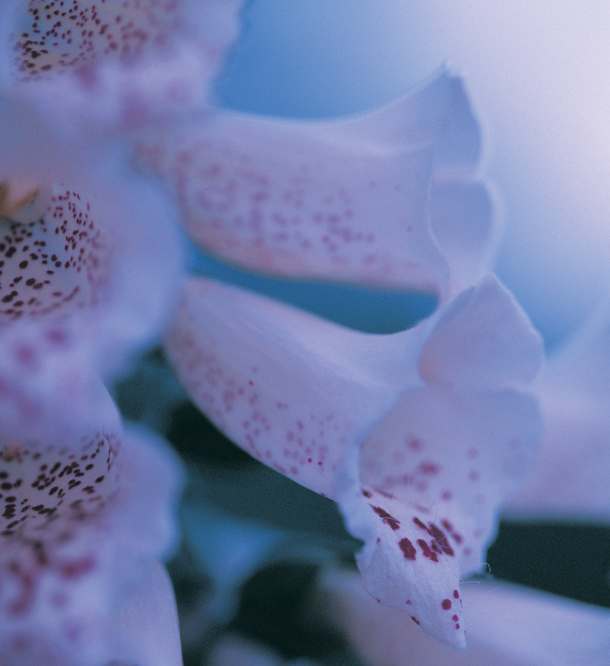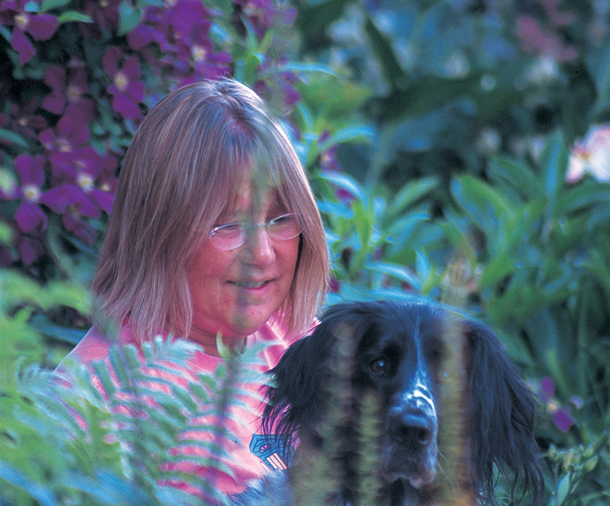| Current Issue |
| View as PDF |
| features |
|
Families rise to the challenge |
|
Building for the future |
|
Blooming in Bellevue |
| departments |
| Habitat Hits |
| Organize it |
| Source it |
| Number it |
| Do it |
| Revive it |
| Decorate it |
| Pick it |
| the guide |
| Habitat 2008 |
| Contact Us |
|
About
Us/ Contributors |
|
Current
Advertisers |
|
Copyright © 2009 Express Publishing Inc. All Rights reserved. Reproduction in whole or in part in any form or medium without express written permission of Express Publishing Inc. is strictly prohibited. Habitat magazine is distributed free one time a year to residents and guests throughout the Sun Valley, Idaho resort area communities. Subscribers to the Idaho Mountain Express newspaper will receive the Sun Valley Guide with their subscription. |


Photos by Nick Stelma
Blooming in Bellevue
By Jennifer Tuohy
Photos by Nick Stelma
One block from Highway 75, a peaceful oasis lies in the heart of town. A lush, opulent sanctuary, Evan Stelma and Bart Lassman’s garden is filled with a bevy of beautiful blooms. Reminiscent of a secret English garden, this Bellevue haven illustrates how to create lasting color in the cold mountains of central Idaho.
When the couple purchased their first home together, 11 years ago, they tasked themselves to create Evan’s dream garden from half an acre of lawn, a handful of blue spruce and aspen, and a soil bed of river rock. More than a decade later, hours of passionate hard work have produced a paradise. The once plain, rectangular yard now sings with a symphony of vibrant flowers, exotic leafy trees and seductive stone curves.

A few samples from Evan Stelma’s botanical haven include, foxglove blossom (Opening image), moonshine yarrow (top), red yellow throated daylilies and pink monarda (below).

In this garden, a discovery waits around every carefully crafted corner. A blue hammock lounges under native chokecherries—Bart’s favorite resting place. A white, wrought-iron gazebo—built for a son’s wedding—is almost obscured by six exuberant
Fragarioides that provide a cool green siding and an inconsequential white flower. And tucked into a hidden corner, a small arbor guards its treasure: a stone-and-steel, circular Mark Stasz sculpture. The serenity and surprises of this space welcome you in and ask you to lose yourself."A riot of colors," is how
Evan, a Wood River Valley native, describes it. "Not as peaceful as
some," she explained drily. "There are pinks and blues and yellows, and
a smattering of red, plus the occasional titch of orange that slipped
through the cracks."
The garden, with its informal design, has become another living area for
the couple. A simple patio just off the backdoor provides a serene
setting for quiet summer dinners surrounded by the fruits of their
labor. Spreading into the small lawn, stone pavers weave through
flowerbeds stuffed to bursting with English roses. Evan’s roses are her
biggest joy. Sitting, sipping wine, enveloped by these English gems, she
is in her personal paradise—"I love the fragrance of a garden, so that
has guided many of my choices. All my roses must smell wonderful first;
color and form are secondary."
The pavers continue on, finally ending at a large, cedar pergola. Perfect for entertaining, the pergola’s picnic table places diners under the succulent, sweet-smelling white flowers of two
Shiro Noda, a Japanese wisteria, that eagerly consumes the pergola’s sturdy shape.The garden sits sheltered in a northwestern corner of Bellevue. Facing east, it enjoys a southern exposure. Evan attributes much of her success to the location, shielded as it is from the valley’s harsh winds. "We have a month more of growing season down here. I can grow more, and I can push zones." Specified by the USDA, planting zones guide gardeners in particular climates. Bellevue is Zone 4. Experienced gardeners like Evan enjoy pushing these zones and nurturing unusual plants in unexpected places. "I have a Japanese forest grass that shouldn’t be perennial here that’s made it through two years," she said with obvious pride. A Sieboldiana maple and the vase-shaped Amur maackia tree, both from China, also thrive in this traditionally frosty zone (they favor zones 5 and 6), alongside a ballerina loebner magnolia that blooms healthily each spring. Evan’s favorite oddity is the slow-growing, pink-flowering dogwood. "This is a real stretch for here." She has to dig it out each winter so the snow doesn’t break its delicate, layered branch structure.

Dianthus
(sweet Williams).
Beyond this versatility, the garden is remarkable for its longevity. It blooms for seven months each year. The first signs of color emerge from the bleak, white landscape in April. "It starts with the bulbs, mainly daffodils, narcissus and tulips," said Evan. Next are the bleeding hearts and a huge variety of brunnera, hostas, columbines, leopard’s-bane, bachelor’s button, dianthus, violas, rockcress and Jacob’s ladder. "Every year there is enough of a shift in the weather that different things bloom together so the garden always looks new," said Evan. The last week of June through early July is the heyday. Delphiniums, sweet Williams, poppies, lupines, lamb’s ears and a slew of daylilies explode in a cacophony of color.
By late October, the blooms are spent. But fall brings its own wash. Crabapple trees, maples, bur oak, red mountain ash berries, and a Virginia creeper vine on the fence bestow their classic autumnal hues. A row of burning bush is a beautiful line of hot pink along the garage.
The smorgasbord of color, fragrance and texture emanating from hundreds of varieties of trees, plants and flowers (almost exclusively perennials) come from hard work and a willing husband. Bart, fire chief of Wood River Fire & Rescue, spends most of his free time maintaining and building the space for Evan’s grand plans. "She says where it goes and what it is, and I say, ‘How deep?’"
The couple, together for 17 years, claim they never leave the valley while there is color in their garden. "We live in paradise, why do you need to leave?" said Bart. "We enjoy coming home every day. How many people can say that?" Devoting an estimated 24 hours a week to their desert oasis is worth every second, said Evan. "I love the peace. If I’m having a really crummy day, I can go out and start deadheading and picking weeds, and I feel happy in about 15 minutes."
Evan's tips for constant color
• For an endless summer garden, plant late-season perennials such as rudebeckia, butterfly bush, echinacea, stargazer and Casablanca lilies, reblooming daylilies, endless summer hydrangeas, pee gee hydrangeas, honeysuckle vine, garden phlox, autumn joy sedum, new dawn climbing roses, foxglove, reblooming iris and goldenrod.

Evan and Loki
sit in front of ferns and under jackmanii clematis.
• Vines, trees and shrubs provide their own wash of color in a garden. Evan uses Virginia creeper ("A living wall between our house and the neighbors"); honeysuckle; clematis (jackmanii, huldine, alba luxurians); Kiwi vine; silver lace vine ("Grew vigorously, to the point that it grew under the siding and trim of the house and started to grow up the roof"); hybrid lilacs; flowering crabapple trees; Santa Rosa plum trees; sweet cherry trees ("Bing, Stella and Royal Anne. All do well here. The only problem is beating the robins to the cherries").
• Visit local nurseries throughout the year to see what’s blooming and when.
• Watch your water. People kill plants by over-watering as often as by under-watering.
• Ask for advice. Local garden centers have knowledge to share. Listen to their advice.